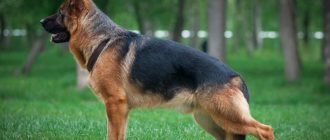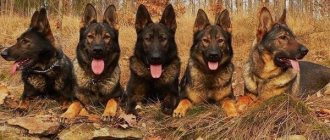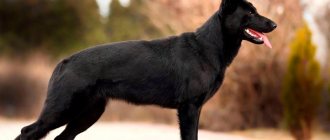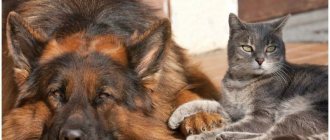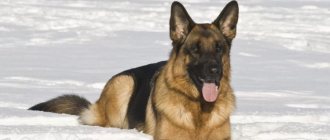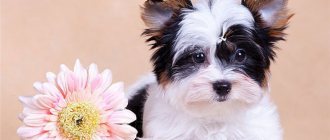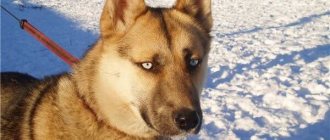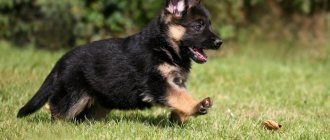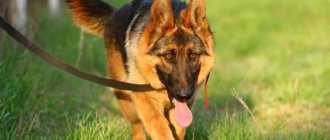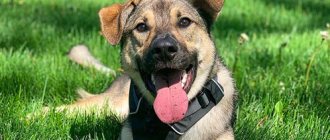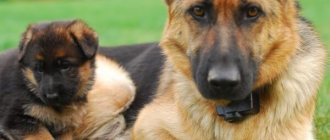The German Shepherd is one of the most common breeds in the world. This type of dog is strongly attached to its owner, adopting manners and emotions, becoming the best friend. The worst thing for a “German” is separation from his owner, even for a short period of time. The main characteristics of this large breed are courage, confidence and intelligence. An attractive and loyal animal can be not only a pet, but also a reliable guard and comrade in the service.
This is a strong and muscular, fast and energetic breed, endowed with good intuition and easy to train. Another advantage of the breed is its thick, beautiful coat, which can protect even from severe frosts . And although according to the standard the norm is black, black and red or black and tan, there are also motley dogs.
Read the article on the topic: “All shepherd dogs with names and photos - 60 species in alphabetical order.”
Care and maintenance
Black representatives of shepherd dogs are unpretentious in keeping, they get along well even in city apartments, subject to long walking and regular training. Keeping it in private homes is permissible even in an enclosure; the breed is hardy enough to easily survive the winter if provided with a warm kennel. But from the point of view of animal psychology, “Germans” are much better off living next to their owners; this dog was born to work in tandem with a person. A long separation from their flock is hard for shepherds to endure.
Nutrition
Black German Shepherds have a relatively “weak” stomach, which is why more and more professional breeders are choosing commercial dry food. Modern ready-made super-premium food or holistic food for large breeds meets all the requirements of a balanced diet. Economy and premium food are not suitable for German shepherds, although their price is much more reasonable. But a large number of cereals in the composition are not nutritious enough, and much more cheap food is required per feeding, compared to “holistic” food.
Natural feeding is very difficult to balance correctly on your own. The diet must include:
- Muscle meat and offal – 2/3 of the total diet.
- Low-fat cottage cheese and kefir.
- Vegetables and unsweetened fruits.
- Cartilage and tendons.
A categorical taboo for all shepherd dogs:
- sweets and chocolate;
- bones;
- spoiled food;
- salt, spices.
Sources of carbohydrates (porridge) in a dog’s diet are acceptable, no more than 10% of the total feeding portion.
Health
Conscientious breeders carefully reject sick animals from breeding, buying a puppy from a good nursery; the chances of buying a sick animal are minimal. When raised properly, the Black German Shepherd is a strong and healthy dog.
Rational feeding, regular exercise and timely examinations by a veterinarian are the key to your pet’s health.
Vaccinations
Immunizations are carried out to ensure the safety of infection with infectious diseases. The first vaccination is given at the age of 7-8 weeks, with preliminary double deworming. After 21 days, revaccination is carried out with the same drug to consolidate the result.
Along with a double vaccination against infectious diseases, an injection against rabies is often given. Sometimes the veterinarian postpones vaccination against rabies until the teeth have completely changed; this depends on the conditions under which the pet is kept and the epidemiological situation in the region of residence. After all vaccinations, quarantine is observed for at least another 10 days.
After immunization, animals may experience weakness, lethargy, and refusal to eat. Allergic manifestations to modern serums are not observed.
Diseases
Despite the strength and endurance of black German Shepherds, the excessive popularity of the breed has led to a number of breed diseases:
- Volvulus.
- Dysplasia of the hip or elbow joint.
- Weakened ligaments and tendons.
- Metacarpal measurements.
- Cryptorchidism.
- Intervertebral disc prolapse.
- Dysfunctions of the digestive system.
- Inflammatory diseases of the cornea of the eyes.
Breeders are trying to fight breed diseases, but while there is a demand for puppies without pedigree documents, health problems remain.
Walk
Shepherds are an active breed that requires appropriate walking. Without proper physical activity, manifestations of destructive behavior are common - excessive barking, digging, chewing on things in the house. An adult “black German” needs to be walked at least 2 times a day, 1.5 – 2 hours for each walk. Puppies should go outside 4 times a day, as young animals need to relieve themselves more often.
Grooming
Short-haired representatives of the breed are not fussy about grooming. It is enough to wash the dog once a month and comb it 1-2 times a week with a slicker brush and then with a furminator. During muddy weather, to keep the house clean, it is recommended to wash your dog's paw pads and belly with a mild shampoo or special paw soap.
You cannot use human shampoo, as this will lead to dry skin and fur and the appearance of dandruff.
For long-haired representatives of the breed, grooming is much more difficult. The frequency of washing does not change, but you need to comb your pet much more often. To care for long guard hair, you definitely need a comb with sparse teeth, which will have to be combed daily to prevent tangles from forming. Also, after standard bath procedures, it is strongly recommended to use a special balm.
Recommendations
In conclusion, let's look at a few general recommendations:
- It is not recommended to buy an adult dog for your apartment if you already have other animals (for example, cats or other dogs). There is always a risk that the animals will not make friends, which will turn your life into a nightmare. Therefore, check with the seller in advance whether it is possible to return the dog if it does not make friends with other animals.
- It is recommended to consult a veterinarian regarding food, since there are many expensive but low-quality foods on the market today. If you eat poor food, the risk of developing gastrointestinal diseases and allergies significantly increases, so it’s not worth the risk.
In conclusion, many people take two puppies at once so that the dogs do not get bored. This approach is correct, but keep in mind that two shepherd dogs will play and run around the house a lot, which can lead to damage to furniture, appliances and flooring. Therefore, it is recommended to take very calm puppies so that your home can survive. If you live in a house, then this problem is not critical - after all, puppies can be kept outside during the warm season.
Black
Black color is much more common: in almost all shepherd breeds. These are, for example, the Australian shepherd, the Anatolian, the Scottish shepherd, the Belgian Groenendael shepherd, the same Greek and Central Asian, the Australian kelpie and coolie, the briard (its fur is similar in structure to that of a goat), and the mudy.
The Beauceron is a French shepherd dog with a smooth, shiny black coat.
He is considered the most difficult dog in the world to train, because despite his excellent qualities (responsibility, intelligence, devotion), he is extremely willful.
Black Beauceron
Among his admirers is the French writer Colette, who kept many Beaucerons.
Color of German Shepherds not confirmed by the standard (mutations)
Sometimes, as a result of improper crossing of subspecies, a defect in the color of the puppy is formed. Another such phenomenon can occur with genetic disorders of the hereditary type (lack of the necessary pigment). In this case, the puppy will be completely healthy, but it cannot be used for breeding. Such a dog will also not be able to participate in exhibitions. Often these shepherds have an extraordinary appearance and unique color. Suitable as a pet and companion dog.
Possible colors of a shepherd dog that are not confirmed by standards:
- Ginger. Very rare. It occurs as a result of a lack of black pigment or crossing a purebred shepherd with a dog of a foreign breed. If there are black spots on it, the dog gains the right to compete for titles at shows.
- White. If the color is white, there was an error in crossing the dogs. If the nose is also white, then the dog completely lacks coloring pigment. She is an albino. This phenomenon is extremely rare. Albino Shepherds are incredibly beautiful, but are not allowed for breeding.
- Blue. It occurs as a result of incorrect crossing of zoned shepherd dogs and black-haired individuals. The puppy turns out to be a light blue, silver shade. Despite his attractive appearance, he does not meet breed standards and is regarded as a genetic mutation.
- Roan. The coloration resulting from the growth of a large number of gray hairs in a dog. The shade takes on an ashen tint and is considered a gene mutation.
- Yellow (solid). This color can be determined due to the mating of a German Shepherd with a non-purebred representative of the breed. Such puppies are not allowed for breeding. They live with people as pets. Other breed qualities have been preserved.
- The mottled color results from uneven pigmentation of the coat. The usual color pattern is disrupted, inclusions appear that are not typical for the breed standard.
Shepherd dogs can have different shades of fur. Some of them are not provided for by breed standards. A dog with this problem will make a great family friend. The color does not affect its intellectual abilities and gives the dog uniqueness. Video No. 1
Video No. 2
https://youtube.com/watch?v=DSss9_t3uoY
Breeding lines
The incredible popularity of this extraordinary breed has led to the emergence of a large number of its subtypes in different countries, differing both in appearance and character traits.
Exhibition of West Germany (High Breeding Lines).
These dogs are closest to the standard. They are bred primarily for exhibitions.
Since the main attention during reproduction is paid to the exterior, and not to the development and preservation of working qualities, these animals have significant disadvantages - weak character and service qualities
Show dogs have a luxurious coat of predominantly saddle color with bright tan marks, but sometimes you can also find zone-colored specimens.
If we talk about ideals, then there are also opposites, for example, the dwarf German shepherd. You can read about it on our website.
The highly bred Sheepdog is good as a family member and friend, and can also be used to participate in sporting competitions. But, if you need a guard or a service dog, opt for another type of German shepherd (photos and names can be found in this article and on our website).
Working lines
These strong dogs (sometimes called service breeding), while less elegant than their show line counterparts, are much more similar to the very first representatives of the breed.
A working German Shepherd can come in a variety of coat types and colors. Zoned, black or black and tan - all colors of German shepherds are typical for these dogs; you can often find black and white colors.
The priority goal of breeding all working Europeans is service qualities.
German Shepherds of working breeding are instinctive in their behavior, they have a strong nervous system and a lot of energy. They are demanding of training and workload, aggressive, and temperamental. Working bred German Shepherd puppies are carefully selected for service and undergo multiple training courses. You can read more about German Shepherd puppies and pregnancy in our article.
Such dogs are most suitable for police, military, drug and explosive detection, they are excellent search and rescue dogs, and are also suitable for personal protection.
For a family living an active life, ready to devote attention and time to their pet, a working European will be an excellent companion, but do not expect calm, measured and phlegmatic behavior from her.
American line
American breeders focused on the appearance and speed of movement of dogs, leaving aside their working qualities. Shepherd dogs are taller, they have an elongated body with a narrow head, they have a somewhat angular shape. The saddle color (sometimes called suit) is common, but other standard colors are also found, as well as pure white.
American dogs are gentle in character, balanced and calm. They rarely show aggression and are highly trainable. However, there are such disadvantages of the breed as excessive emotionality and poor health and nervous system. These beauties will be good companions and loyal family members.
English line
In addition to the listed types, which are widespread, there are less popular varieties of German shepherds that arose as a result of mutation or selection. These are such subtypes as Panda, Czechoslovakian Wolfdog and Sarlouz Wulfhound, Kunming Shepherd and others.
Rules of care
Caring for zoned Germans is usually not difficult for owners. These are quite unpretentious animals in terms of keeping conditions. During the shedding period, the shepherd dog must be brushed every day; in normal times, it is enough to carry out this procedure 3-4 times a week. For combing, you can use a furminator or a special mitten.
The pet's eyes, ears and mouth must be inspected every day for dirt and possible inflammation. Cleaning is done as needed. The procedure for trimming nails for this breed is usually irrelevant; walks are enough, during which they grind down on hard surfaces on their own. However, if necessary, you can use a regular nail clipper.
Zone color
Puppies of the zone color, which is also called wolf color, are becoming less and less common today - some of the young dog breeders have never even seen a representative of the classic “wolf” color. However, it is generally accepted that it is the zonal coloring that is the original for representatives of the German breed - all other options are its derivatives.
The zone-gray color is dominant in the German breed - if during mating one of the parents is gray in color, this will definitely show up. However, on the other hand, this gene does not exist in a recessive form, therefore it will not be possible to obtain it on the basis of zonal or black-and-white flowers. Consequently, if the producers of the zone-gray color disappear, it will be lost forever to posterity.
However, breeders who follow fashion trends and think more about financial interests than about the conservation of endangered species, rarely think about the consequences of underestimating the factors contributing to the disappearance of the “wolf” color. Therefore, it is worth talking about this more often and more in order to be able to avoid danger and correct the existing situation.
Genetics
Genes and alleys are not a fully studied topic. Sometimes it is unclear why a dog has this particular color. The pigment responsible for fur color is melanin. In turn, it is already divided into two pigments, which are responsible for dark and reddish colors. Among the variants of reddish shades, yellow ones can also appear. We will try not to delve too deeply into the nature of genes, but we will still look a little.
There are two types of genes: dominant and repressed. Dominant - main. Accordingly, most of the dog will be influenced by this particular gene. The suppressed gene is minor. Thanks to it, spots, lines, and patterns will appear.
The location of genes is a section of a chromosome. There are only 12 such departments, and there are from 2 to 6 gene variations in each department. It is not necessary that all these genes will be in each department.
German Shepherds are divided into several types - so-called lines. Each line is a breeding site for a given breed. There are about 10 such lines in total. Each line differs from each other in its location and its pattern. There are a huge number of color options.
The East German line, Czech, American and even Old American are common. Among the unusual lines, the panda stands out especially. This dog has an incredible black and white coloring, reminiscent of a panda's coloring. There are also varieties without a mask. Such shepherds do not have the usual pattern on their muzzle.
And to make it clearer, we should consider all the most basic types of colors of German shepherds.
Basic moments
- The White Swiss Shepherd is a strong, temperamental, hardy, very energetic dog with a strong nervous system.
- Outwardly, with the exception of color, it is similar to the German Shepherd, but, unlike that one, it is less reckless, excitable, and demonstrates aggression only in the case of an obvious threat.
- The dog is incredibly affectionate with all members of the household and extremely friendly towards children.
- The shepherd treats strangers with restraint, does not like familiarity towards itself, but will not show aggression.
- Lives in peace and harmony with other pets, including cats.
- The Swiss Shepherd is highly intelligent, quick-witted, and very easy to train.
- Easily socialized in human society - can cope with the functions of a guard, guide, rescuer, tracker guide, watchman. Representatives of this breed often serve in law enforcement agencies.
- Dogs love to lead an active lifestyle and need regular exercise and movement.
- They are distinguished by excellent health, and even at an advanced age they remain active.
- The best place for a White Swiss Shepherd to live is a country house, but its unpretentious character and ability to adapt to any conditions allow it to be kept in an urban environment.
Many dog lovers get white Swiss shepherds, being captivated by the spectacular, unusual appearance of these animals. Only over time do they discover their magnificent qualities inherent in serious service dogs. This beautiful, affectionate, good-natured dog, with an impressive texture, is unpretentious and hardy, easy-going and tireless in games. The love of White Swiss Shepherds for their owners is boundless; they need to know that loved ones are nearby, to feel family warmth and to feel needed.
All types of shepherd dogs with photos
All shepherd dogs can be divided into two large groups:
- Cattle dogs (are engaged in gathering the flock, making sure that the animals do not wander off and go in one direction);
- Guard dogs (protect from attacks by predators). To get the job done, the farmer must use dogs for different purposes.
Nowadays, shepherd dogs have not lost their working qualities and are still used for their natural purpose. But dog handlers found other advantages in these dogs: quick reaction, good sense of smell, dedication to the task and the owner, keen eyesight, responsibility. Therefore, breeds are used in rescue services, border troops, and in hospitals to accompany seriously ill people. German and Caucasian Shepherds have proven themselves well.
In addition, special exhibition specimens are bred. They are distinguished by ideal external characteristics, thick hair, and developed memory for remembering complex commands and tricks. This trend leads to the degradation of working breeds and is not particularly popular with dog handlers.
Grey
Greek and Central Asian, South Russian Shepherd Dogs, Briard - these are the breeds that can have a gray color.
An interesting breed is the Puli, which comes in white, gray, and other colors.
Puli dog
The fur is formed into cords that completely hide her brown eyes. Puli is a very smart and loyal, but also a serious dog.
If she thinks her owner is in danger, she will attack without warning.
The Catalan Shepherd is found in both gray and other colors.
Catalan Shepherd
Her coat is hard, with a thick undercoat, the dog is decorated with a lush collar, mustache, beard, and bangs. The wool is long.
The dog's appearance is very funny, and his character is energetic and cheerful.
The Romanian Mioritic Shepherd is massive, covered with thick white or fine hair, sometimes with different spots. She is surprisingly obedient and extremely affectionate.
Romanian Mioritic Shepherd Dog
Only the owner himself can train her: she “falls in love” with only one person, once and for all. The Romanian Shepherd will never betray its owner, even if he is no longer there.
Breed Features
Males of the German Shepherd breed are about 60-65 centimeters tall, females are slightly smaller - 55-60 centimeters. Their weight is 30-40 and 22-32 kilograms, respectively. The body of the animals is slightly stretched, the head is not very large and wedge-shaped, narrowing closer to the nose. The wide ears are shaped like a triangle, set quite high, with pointed tips.
The almond-shaped eyes of Germans are dark brown in color. The neck is not too long, the angle of elevation is about 45 degrees. When running, it bends, and if the animal is alert, on the contrary, it rises a little. The back is wide and muscular.
The front legs of German Shepherds are smooth and straight, the hind legs are slightly shorter and very well developed. The tail is saber-shaped and slightly curved. The coat depends on the type of animal, in some cases it is hard and short, in others it is quite long and much softer, with a well-developed or, on the contrary, dimly defined undercoat.
Features of care
The main stages of caring for a black German are general hygiene procedures. A dark-colored shepherd will need extra care for its coat. Short-haired dogs are brushed once every 6-7 days, long-haired shepherd dogs every 2-3 days. During the molting period, in autumn and spring, the number of procedures is increased to 1 time per day.
Bathing
It is recommended to bathe your dog 2-3 times a year. For washing, use plain water (bathing in reservoirs); the use of special shampoos is allowed. It is not advisable to treat black hair with simple soap, since the hair will become tangled and gather in shreds.
Ears, teeth, claws, eyes
The following require more attention:
- Ears. Once a week they are cleaned with a clean cotton napkin, without getting inside.
- Teeth. Once a month they inspect and clean.
- Claws. As it grows, I cut it with small scissors.
- Eyes. If there is tearing or accumulation of pus, they are washed and medicine is instilled.
Non-standard suits of the “Germans”
Unusual animal colors are the result of mutation. Such dogs are not allowed to breed, although they often look very impressive and are the decoration of nurseries.
Black and white shepherd
Training a German Shepherd at home
Color variation is not recognized as a standard, despite the fact that pets with white spots on their chests look very pretty. The working qualities of such animals are no different from the breed varieties. Eye color is always dark, brown or chocolate. The main shade is black, snow-white is represented by only a few spots.
Note! White spots are a defect even in those dogs that have a classic standard color
Gray (blue)
If the black shade of the coat is lightened, a blue or gray shepherd appears. Such pets are discarded because their dark color has reduced pigmentation. However, in the United States, such pets are in fashion, so 4 shades have been developed, including those with silver splashes. The eyes of these dogs are light yellow.
Blue puppies appear very rarely in a litter; the non-standard color is associated with an additional gene. The presence of red tan marks is allowed. The performance characteristics of the gray animal are indistinguishable from those of its standard relatives.
This pet will never be able to take part in exhibitions
White German Shepherd
A snow-white puppy can appear in the litter of ordinary parents, but only if both have a recessive gene responsible for color. Breeders and fanciers liked the unusual dogs so much that in 2003 they were recognized as a separate breed in the USA and Canada.
Note! They cannot be called albinos, since their nose and claws are black, and the irises of their eyes are dark. The edging of the mouth and eyelids is dark, there is also black skin near the nose
Unlike snow-white cats, dogs do not suffer from deafness. Light spots can occur in animals of other colors, but this is grounds for culling
The edging of the mouth and eyelids is dark, and there is black skin next to the nose. Unlike snow-white cats, dogs do not suffer from deafness. Light spots can occur in animals of other colors, but this is grounds for culling.
These animals are distinguished by their good-natured character and good performance characteristics. However, they lose to other shepherd dogs in guard duty. Such dogs are sociable and sincerely become attached to the owner.
They rarely show aggression, but are ready to bravely defend the owner and his family members
White “Germans” are not albinos
Golden
This is a variety of red color, a lightened version. Animals do not have the right to engage in exhibition activities and are not allowed to breed offspring. The wool is light, beautiful golden tone. There may be light or even white spots on the chest.
Note! There is a black edging around the eyes, the muzzle is decorated with a dark mask. The Golden German Shepherd is not recognized by the breed standard.
The Golden German Shepherd is not recognized by the breed standard.
Brindle color
It is considered extinct, although previously it was the tiger coat of shepherd dogs that was considered the most popular. The gene for this color is expressed in tan: with saddle and black and tan base colors, black areas of the hair are observed, which is why the coat resembles a brindle. The option is interesting, shepherd dogs look very attractive, but at the moment breeders are not trying to revive the color.
Red-haired "Germans"
The red shepherd has a recognizable, interesting appearance, but the color variant is not recognized as a standard. The pet will become a loyal friend and family member, but will not be able to take part in exhibition activities. Such dogs are not allowed to breed. They can be either long-haired or short-haired. The color of the coat can be reddish-brick. Such shepherd dogs are born extremely rarely. The fur coat will be decorated with white spots of various shapes and sizes.
Note! A bright red tone is allowed as an additional color for black and tan coloring, as well as on the markings for black and tan varieties. There are also spotted “Germans”, their fur is decorated with pigment spots of various shapes and sizes.
Most often, these are not purebred dogs, but the result of a mating between a purebred shepherd and a yard dog.
There are also spotted “Germans”; their fur is decorated with pigment spots of various shapes and sizes. Most often, these are not purebred dogs, but the result of a mating of a purebred shepherd dog with a yard dog.
Red color allows for tan marks
Price range
The cost of a healthy “German” is 25-50 thousand rubles for puppies and 10-20 thousand for adults. You can adopt a dog for a small price in private or municipal shelters, although you will have to tinker with new shepherd dogs quite quickly, so you will have to look for news on new dogs. The cost of the animal is affected by the following parameters:
- Pedigree. The better the dog’s pedigree, the higher the cost of the final litter. Pedigree dogs in good health can cost up to 100 thousand rubles.
- Color. The sable color has a certain variability, and some color options may confuse new breeders. Therefore, the cost of puppies with the “stereotypical” saddle color will be higher.
- Floor. Females are 20-30% more expensive than males. This is due to the fact that females are often bought for breeding, which creates additional demand for them.
Attention! When buying a dog, be sure to take the documents for the animal in case of further breeding.
Varieties of shades
Zone color is divided into 2 groups:
- zonal gray;
- zone-red.
The zone-gray color originates from ancient times. Nowadays you rarely see dogs with this coloring. Such animals have a dark ash back and sides, a pronounced black mask on the muzzle, and lighter-colored fur in the chest, abdomen and paws.
Zone-gray shepherds resemble wolves in color
The zonal red color is not popular among cynologists, although it is approved by the list of the Russian Cynological Federation. These dogs have brown-red paws, belly and chest, a black mask on the face, and a darker color on the back and sides.
Important! Until the age of 3, the dog’s color may change to become brighter and more saturated.
Skin pigmentation
Particularly expressive to the representatives of the breed is the mask - the part of the muzzle around the eyes, which is most often completely black. The dominant gene is responsible for it. If the animal's fur is dark in color, the mask is often weakly expressed. A pet with a light coat has a more saturated color of the mask. Its absence is considered a breed defect.
The black and tan animal does not have a mask, its muzzle is black. The throat area is colored brown, the edging of the lips is liver-colored.
The color of the eyebrows and forehead of saddle-backed shepherd dogs directly depends on the tone of the saddle coat. If its color is deep dark, then the animal’s forehead is also charcoal. An expressionless lightened mantle is in harmony with light eyebrows.
Note! The zone-colored German Shepherd has sable eyebrows. These are the main color options for shepherd dogs
Those who want to engage in breeding or take part in exhibitions with their pet should choose a dog with a recognized standard color. If these points are unimportant, then the choice is richer: you can buy a golden or red puppy. A dog's intelligence and working qualities have nothing to do with the color of its coat.
These are the main color options for shepherd dogs. Those who want to engage in breeding or take part in exhibitions with their pet should choose a dog with a recognized standard color. If these points are unimportant, then the choice is richer: you can buy a golden or red puppy. A dog's intelligence and working qualities are in no way related to the color of its coat.
Proper care
The great advantage of the breed is its unpretentiousness. However, during the shedding of a short-haired German Shepherd, you cannot do without a special comb, with which the dog needs to be combed twice a week. And with special scissors you need to trim long hairs of fur. As for water procedures, three baths a year in the warm season are enough for the dog. Experts do not recommend bathing your shepherd dog more often, otherwise its coat may lose its natural shine.
Tartar is another problem for the breed. To prevent its occurrence, you need to give your dog a special dental stick at least once a week, which you can buy at a veterinary pharmacy. Also, do not forget about going to the veterinarian, who must examine the dog’s oral cavity and make sure that everything is good and meets the requirements.
Colors of German Shepherds according to the standard
Thanks to a lot of work on the selection of German herding dogs, several standard colors were developed. In addition to the familiar saddleback, which is represented by a V-shaped “mantle” of absolutely black color on the back and large tan marks on the chest, paws and belly of the pet, there are 3 more types of color. They may differ in the degree of color intensity and are divided into subgroups.
According to the standard, there are the following colors of German Shepherds:
- black-and-white;
- black and tan;
- zonal;
- black.
All of them can have their own varieties, which are not a color defect, but have varying degrees of coloring. That is why in groups there is also a division into subgroups, which include different colors within the same color range.
Cheprachny
More than 90% of all dogs of this breed have this color. It is represented by a wide black spot on the pet's back. It can extend to the base of the tail, sides of the animal and elbows. The dog's underbelly, chest, part of the muzzle, and paws are usually colored red.
The main thing is that the dog has a black mask. Its absence is considered a breed defect
The degree of coloration and intensity of the red color on the pet’s belly is not very important, but at exhibitions preference is still given to individuals with a darker shade of tan
Black and Tan
Often distinguished as a separate type, but still they are representatives of the same group. They have an intense black color over almost the entire body. Tan areas are located only on the lower abdomen and the inside of the paws. The presence of red spots on the eyebrows and cheekbones of an animal is not considered a defect.
It is noteworthy that when an animal is mated, in subsequent litters this color is found less and less often. In addition, tan is able to lighten over time, unlike pure black, which will remain with the dog forever.
Zonar
This color is represented by only 5% of the breed. Other names that can be found in canine literature are “agouti”, “wolf” or “gray-haired”. The coat is unevenly colored. At the very base it is light, then black, after that yellow and at the very tip dark again. Rich shades are found on the dog's back, tail and face.
Black
A luxurious, completely black coat distinguishes these pets and sets them apart from other representatives of the breed. This color is the least common, not more often than 3% of animals. The inclusion of any other color, as well as the presence of light claws, or altered pigmentation of the nose will be considered a color defect. The dog must be completely black.
How to choose?
First of all, you need to decide: what is such a dog for - for work, sports or for exhibitions? Based on this, you need to select suitable working or exhibition lines.
But, in any case, you need to buy a puppy only with documents of origin.
When purchasing a working dog, it is advisable to inquire whether the puppy’s parents have training diplomas . Also, the mother and father of the future pet must have medical certificates stating that they are free from hereditary diseases.
IMPORTANT!
When choosing a puppy, in addition to its exterior characteristics, you need to pay attention to the state of health, the quality of raising and the psyche: the baby should be cheerful, active and active, and, moreover, not thin and not too small.
When choosing a show pet, experts recommend choosing a medium-sized puppy.
Before you finally decide on one or another baby in the litter, you need to carefully examine it so as not to miss signs of possible illness . Sick puppies should not be adopted under any circumstances.
When do shepherds change coat color?
Like the change of teeth, the very first shedding is very important for the animal, including the German Shepherd. During this period, the smooth coat is replaced by the coarse coat of an adult. The beginning of molting can be observed at approximately 3.5–4 months. By 7 months you can already see a clearly outlined saddle cloth. By 10 months, growth at the withers ends, but the animal is not yet considered an adult dog.
Puppies are born very cute and plump. The number in one litter can reach twelve! And everyone will most likely look about the same. Only with age will each puppy develop its own unique color. And from birth until about three weeks of age, they all have approximately the same appearance - a pointed muzzle, a large black nose and short shiny fur.
Starting from the first week, your pet's coat requires special care. Be sure to bathe 2-3 times a week, as well as combing after it. During periods of shedding, the dog's requirements increase: brushing is required daily. For this you can use either a furminator, which is very convenient for animals with hair of different lengths, or a metal comb. The second is less convenient, but perhaps it will suit you optimally - each of us is individual.
In order for the coat to look healthy, shiny, and rich in color after the first molt, you need to feed the puppy correctly from the first days of life. Initially, in the first two weeks, the puppy feeds on its mother's milk. Later, complementary foods are introduced
Pay special attention to the meat composition. It should be at least 60% in the diet
The German Shepherd is one of the smartest dog breeds. She has a stable psyche and lends itself perfectly to any training, and can also perfectly adapt to any living conditions. A German Shepherd can be a wonderful friend and an excellent protector for your family. But thanks to care and proper care, your pet will also become a source of pride and beauty.
See below for more information on German Shepherd colors.
Pet Personality
Zonal “Germans” are characterized by such traits as a strong nervous system, balanced temperament, innate protective instinct, alertness, courage, activity and determination.
NOTE!
These are loyal and obedient dogs: friendly towards the owner and members of his family, but at the same time distrustful of strangers.
The zone-colored German Shepherd does not show causeless aggression towards strangers or animals. She is very human-oriented, and, as a rule, strictly follows all the orders of the owner.
A zoned shepherd dog must understand when aggression is appropriate and show it only in situations where it is necessary to protect the owners or their property.
Read more about the German Shepherd's personality here.
Zone color
From the lips of “experts” you can hear the opinion that “a real German Shepherd should be exclusively black.” However, as Stefanitz wrote in his book “The German Shepherd in Words and Illustrations,” the breed originates from a wild ancestor - an ancient wolf with a color ranging from light gray to yellow-brown and dark brown. Zoologists call this color “agouti” by analogy with a rodent, whose fur is colored brown-gray, which is considered an excellent natural camouflage.
In Germany, the wolf color is called “grau” - “gray”, and in the Russian interpretation it is called “zonal”, reflecting the ring-shaped coloring of the hairs: the base of the skin itself is light, followed by a black zone, then gray, reddish or brown, in while the tip of the hair is always black.
This cyclicity is due to the work of the zonal color gene (aw), which periodically switches the production of black and red pigment. Alternative forms (alleles) of the gene determine other variants of the distribution of pigment in the coat, but the zonal color in the German Shepherd is dominant in relation to all other standard colors.
Thus, a dog carrying the aw gene will only have zonal coloring. In turn, gray puppies will definitely be born if at least one of the parents has a similar color.
It is noteworthy that as babies, “zonaris” look gray or sandy with a black “belt” and a black “mask,” but with age, the blackness on the back begins to spread to the sides and the color becomes more dense and bright.
The progenitor of all modern lines is Horand von Grafrath, acquired by Max f. Stefanitz specifically for breeding and recorded in the stud book under No. 1, had a rich zone-gray color and passed it on to most of his descendants. The Horanda type was continued by Hector von Schwaben - Champion of 1900-1901, and in the 20s. In the 20th century, the zonal Claudo von Boxberg, who left numerous offspring both in Germany and the USA, was considered the model of the breed.
At the same time, bright and elegant carriers of the black-and-white color began to come into fashion, maintaining a numerical advantage in livestock to this day, however, the wolf color is considered primordial for the “German”. By the way, the “working” breeding in Germany, which shines at training championships, is built primarily on the lines of zonal German shepherds, and many professional trainers, when choosing a puppy, give preference to dogs of wolf color.
The zone color varies widely in intensity and in some individuals it can be thick, almost black, while in others it can appear blurry, so the whole dog will look light ash or beige-gray.
Behavior, temperament
Despite changing breed standards, modern German Shepherds have perfectly preserved the best potential of their ancestors. The complex of mental qualities clearly defined in the breed includes mental alertness and firmness, combativeness and obedience, devotion to the owner and sensitivity, complemented by balance. The speed of reaction determines the liveliness of the dog’s temperament and is formed by the genotype.
Other characteristic breed qualities can largely be created by man, including such an important factor as the obedience of the German Shepherd against the backdrop of its innate desire to listen to the leader. Shepherd dogs need to feel a sense of community with people, and developing this feeling is the direct task of the breeder using imprinting. All dogs that have not undergone imprinting are unsociable and extremely difficult to train.
German Shepherd puppies are inquisitive by nature, but the owner of a pet of this breed can develop this feeling in the dog during the process of education and socialization. Fighting and aggressiveness are qualities necessary for a service breed, but such important and genetically determined characteristics are difficult to correct, which must be taken into account when choosing a puppy.
Other colors of German Shepherds
Each breed of dog has shades of coat that are included in the standard description or that are unusual for a particular breed. German Shepherds are no exception. The standard includes only 4 colors, while there are many more non-standard colors.
Standard
In addition to the basic saddle color, pets can be standardly zonal in color, jet black or black and tan. In all cases, except coal, small tan areas with red hair are allowed. Black representatives of the breed should have dark fur, as well as dark claws, nose and eyes. Otherwise, the puppy is rejected.
Unusual
Non-standard shades of wool include absolutely white. But such dogs are not considered albinos. Their snow-white fur is harmoniously combined with a black nose and dark claws, as well as brown eyes. Also unusual colors include spotted and roan pets. Additionally, Shepherds can be completely gray or tan with varying intensities of color.
Despite the variety of shades, all shepherd dogs without exception have good characteristics. They are excellent companions and guards, watchmen and search engines. These are universal dogs suitable for any level of owner training.
Tags
Black-and-white color in Black-and-white color Uzonary color New color of quick-black color. Black-and-white color. so that a shepherd dog can be a real shepherd. A shepherd dog must have a saddle coat. Black-colored ancestors of black-haired shepherds.shepherds of black-haired color.shepherds of black-colored color.time black-haired color Dogs Dog breeds Dogs zonal color Zoner same ZONARY color.essence. Zonal ones are colored by zonal ones. Zoned color why zoned puppies
answeringcatscats
